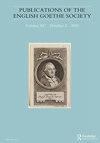Green Glasses in the Classroom: Teaching Heinrich von Kleist
IF 0.1
3区 文学
0 LITERATURE, GERMAN, DUTCH, SCANDINAVIAN
引用次数: 0
Abstract
ABSTRACT Michael Kohlhaas is one of Heinrich von Kleist’s most studied texts. While students may find the dense and complex narrative challenging to understand and interpret, the tale lends itself well to train critical thinking, a key skill in the study of Modern Languages. In a close reading, I argue that engaging with literature from the more distant past, including Kleist’s tale, not only builds bridges to other centuries, but also helps generate an awareness of this bridge-building process. Scrutinizing linguistic and narrative detail, considering and reconsidering different points of view, and acknowledging the historical variability of certain concepts and ideas encourages a dialogue between unfamiliar (fictional) worlds and one’s own world of thought and experience.课堂上的绿色眼镜:海因里希·冯·克莱斯特的教学
摘要迈克尔·柯哈斯是海因里希·冯·克莱斯特研究最多的文本之一。虽然学生们可能会发现密集而复杂的叙事很难理解和解读,但这个故事很好地训练了批判性思维,这是现代语言研究的一项关键技能。细读之下,我认为,参与更遥远的过去的文学,包括克莱斯特的故事,不仅为其他世纪架起了桥梁,而且有助于提高人们对这一桥梁建设过程的认识。仔细审查语言和叙事细节,考虑和重新考虑不同的观点,承认某些概念和想法的历史可变性,鼓励在陌生(虚构)世界与自己的思想和经验世界之间进行对话。
本文章由计算机程序翻译,如有差异,请以英文原文为准。
求助全文
约1分钟内获得全文
求助全文
来源期刊

Publications of the English Goethe Society
LITERATURE, GERMAN, DUTCH, SCANDINAVIAN-
CiteScore
0.10
自引率
0.00%
发文量
15
 求助内容:
求助内容: 应助结果提醒方式:
应助结果提醒方式:


